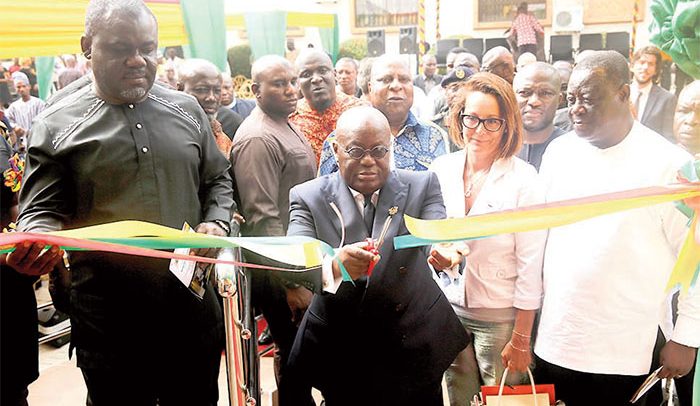President Akufo-Addo cutting the tape to inaugurate the Accra Traffic Control Centre
Ghanaians are likely to see the construction of more roads across the length and breadth of the country in the coming months.
President Akufo-Addo, who dropped the hint, highlighted the commencement of construction and rehabilitation of most of the country’s dilapidated road networks.
He made the disclosure when he commissioned the Accra Traffic Management Centre (ATMC) under the Department of Urban Roads in Accra last Friday.
Speaking at the ceremony, he stated: “Work will commence on the dualisation of the beachroad from the Black Star Square in Accra through Teshie, Nungua up to Tema Community three this year.”
As part of the project, an interchange is expected to be constructed at the Nungua barrier.
These works are to be financed by the China Development Bank with a loan agreement approved by Parliament and Cabinet.
He also talked of other ongoing road construction projects including the construction of the Pokuase interchange which is about 40% complete.
The original contract, according to the President, was for a three-tier interchange; however, he noted that “through efficient management, the interchange has been modified into a four-tier interchange, with the same contract sum.”
But when completed sometime in October 2020 as has been scheduled, the President indicated that the project would bring massive relief to commuters on the Nsawam, Awoshie, Pokuase and Kwabenya roads.
He also talked of the Kumasi road and drainage extensive project which include the dualisation of the Lake Bosomtwi road and the lining of the…river drain in Kumasi which is currently 60% complete; the Tamale interchange project and Tema motorway interchange which would be completed by June 2020, with work on the Teshie Link road progressing steadily.
The President also hinted that the construction of 100 kilometres Kumasi inner roads would commence in September to improve the road network in the city…
In addition to that, President Akufo-Addo said: “Government remains committed to improving road networks in our country in deeds and not with words.”
The President described the ATMC as a major step in addressing congestion in Accra, the nation’s capital.
He believes the smooth flow of traffic in the cities and urban areas, as well as safety on the roads, are critical to the development of the country and to enhance the growth of key sectors of the economy.
“However, we find ourselves in a situation where the upsurge of vehicular traffic, coupled with rapidly increasing urban population, is putting a lot of pressure on facilities in our cities, especially on our road infrastructure, and also sapping productivity. That is why the Accra Traffic Management Centre is such a welcome initiative,” the President said.
“The Centre, the first of its kind in the country and in West Africa, will co-ordinate effectively our capital’s traffic light system, so as to guarantee efficient communications within our traffic light system, thereby ensuring a much smarter way of dealing with congestion on our roads,” he added.
In all, a total of forty-one (41) traffic lights have been upgraded between the Neoplan Assembly Plant at Achimota and the Central Business District of Accra. The upgrade includes the changing of traffic controllers from “isolated intersection controllers”, which could not communicate with each other, to “interconnected adaptive controllers”.
This allows the controllers to communicate with each other along the corridor. With the use of detectors buried in the road, information is carried in real time to the Traffic Management Centre. This allows engineers to observe directly the traffic flow pattern along the corridor, and address any incident on the road that will impede the flow of traffic.
With the Traffic Management Centre, President Akufo-Addo noted that engineers can directly change the signal timings from the centre instead of the old system where they had to carry their tools directly to the field to effect the change.
The President revealed further that cameras are being installed to capture traffic light violations, meaning that the Police Service will have in their possession real-time evidence to help them prosecute motorists, who jump red lights, thereby bringing sanity to the roads.
The ATMC represents Phase 1 of a broader programme to improve mobility and reduce congestion in the nation’s capital.
“Under Phase 2, we shall see the upgrade of the remainder of the two hundred and seven (207) signalized intersections in Accra, from the current isolated intersections to co-ordinated ones. This will include the provision of new traffic controllers, and installation of detectors at intersection points, to collect vital traffic data needed for the improvement of traffic flow throughout the national capital,” President Akufo-Addo added.
By Charles Takyi-Boadu, Presidential Correspondent


